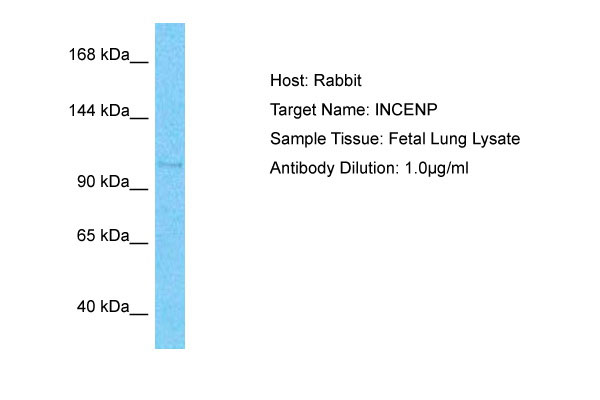INCENP Antibody - C-terminal region
Rabbit Polyclonal Antibody
- 产品详情
- 实验流程
Application
| WB |
|---|---|
| Primary Accession | Q9NQS7 |
| Other Accession | NP_064623 |
| Reactivity | Human |
| Predicted | Human, Mouse, Rat, Rabbit, Pig, Horse |
| Host | Rabbit |
| Clonality | Polyclonal |
| Calculated MW | 105429 Da |
| Gene ID | 3619 |
|---|---|
| Alias Symbol | INCENP, |
| Other Names | Inner centromere protein, INCENP |
| Format | Liquid. Purified antibody supplied in 1x PBS buffer with 0.09% (w/v) sodium azide and 2% sucrose. |
| Reconstitution & Storage | Add 50 &mu, l of distilled water. Final Anti-INCENP antibody concentration is 1 mg/ml in PBS buffer with 2% sucrose. For longer periods of storage, store at -20°C. Avoid repeat freeze-thaw cycles. |
| Precautions | INCENP Antibody - C-terminal region is for research use only and not for use in diagnostic or therapeutic procedures. |
| Name | INCENP |
|---|---|
| Function | Component of the chromosomal passenger complex (CPC), a complex that acts as a key regulator of mitosis. The CPC complex has essential functions at the centromere in ensuring correct chromosome alignment and segregation and is required for chromatin-induced microtubule stabilization and spindle assembly. Acts as a scaffold regulating CPC localization and activity. The C-terminus associates with AURKB or AURKC, the N-terminus associated with BIRC5/survivin and CDCA8/borealin tethers the CPC to the inner centromere, and the microtubule binding activity within the central SAH domain directs AURKB/C toward substrates near microtubules (PubMed:12925766, PubMed:15316025, PubMed:27332895). The flexibility of the SAH domain is proposed to allow AURKB/C to follow substrates on dynamic microtubules while ensuring CPC docking to static chromatin (By similarity). Activates AURKB and AURKC (PubMed:27332895). Required for localization of CBX5 to mitotic centromeres (PubMed:21346195). Controls the kinetochore localization of BUB1 (PubMed:16760428). |
| Cellular Location | Nucleus. Chromosome, centromere. Cytoplasm, cytoskeleton, spindle. Midbody. Chromosome, centromere, kinetochore. Note=Colocalized at synaptonemal complex central element from zygotene up to late pachytene when it begins to relocalize to heterochromatic chromocenters. Colocalizes with AURKB at a connecting strand traversing the centromere region and joining sister kinetochores, in metaphase II centromeres. This strand disappears at the metaphase II/anaphase II transition and relocalizes to the spindle midzone (By similarity). Colocalizes with AURKB at mitotic chromosomes (PubMed:11453556). Localizes to inner kinetochore (PubMed:16760428) Localizes on chromosome arms and inner centromeres from prophase through metaphase and then transferring to the spindle midzone and midbody from anaphase through cytokinesis (PubMed:15316025). Cocalizes to the equatorial cell cortex at anaphase (PubMed:11453556) {ECO:0000250|UniProtKB:Q9WU62, ECO:0000269|PubMed:11453556, ECO:0000269|PubMed:15316025, ECO:0000269|PubMed:16760428} |
Research Areas
For Research Use Only. Not For Use In Diagnostic Procedures.
Application Protocols
Provided below are standard protocols that you may find useful for product applications.
REFERENCES
Adams R.R.,et al.Chromosoma 110:65-74(2001).
Li X.,et al.J. Biol. Chem. 279:47201-47211(2004).
Taylor T.D.,et al.Nature 440:497-500(2006).
Mural R.J.,et al.Submitted (JUL-2005) to the EMBL/GenBank/DDBJ databases.
Ainsztein A.M.,et al.J. Cell Biol. 143:1763-1774(1998).
终于等到您。ABCEPTA(百远生物)抗体产品。
点击下方“我要评价 ”按钮提交您的反馈信息,您的反馈和评价是我们最宝贵的财富之一,
我们将在1-3个工作日内处理您的反馈信息。
如有疑问,联系:0512-88856768 tech-china@abcepta.com.























 癌症的基本特征包括细胞增殖、血管生成、迁移、凋亡逃避机制和细胞永生等。找到癌症发生过程中这些通路的关键标记物和对应的抗体用于检测至关重要。
癌症的基本特征包括细胞增殖、血管生成、迁移、凋亡逃避机制和细胞永生等。找到癌症发生过程中这些通路的关键标记物和对应的抗体用于检测至关重要。 为您推荐一个泛素化位点预测神器——泛素化分析工具,可以为您的蛋白的泛素化位点作出预测和评分。
为您推荐一个泛素化位点预测神器——泛素化分析工具,可以为您的蛋白的泛素化位点作出预测和评分。 细胞自噬受体图形绘图工具为你的蛋白的细胞受体结合位点作出预测和评分,识别结合到自噬通路中的蛋白是非常重要的,便于让我们理解自噬在正常生理、病理过程中的作用,如发育、细胞分化、神经退化性疾病、压力条件下、感染和癌症。
细胞自噬受体图形绘图工具为你的蛋白的细胞受体结合位点作出预测和评分,识别结合到自噬通路中的蛋白是非常重要的,便于让我们理解自噬在正常生理、病理过程中的作用,如发育、细胞分化、神经退化性疾病、压力条件下、感染和癌症。






